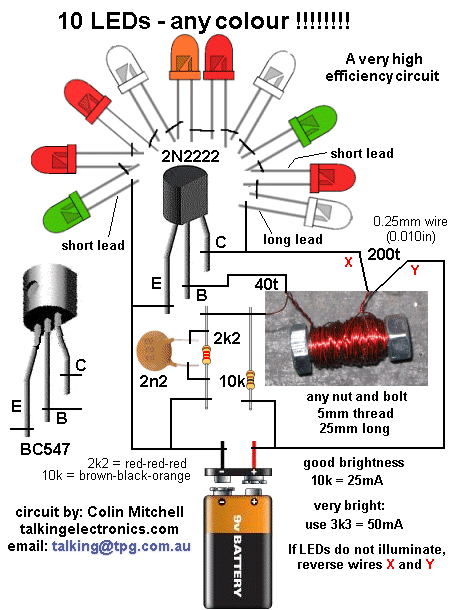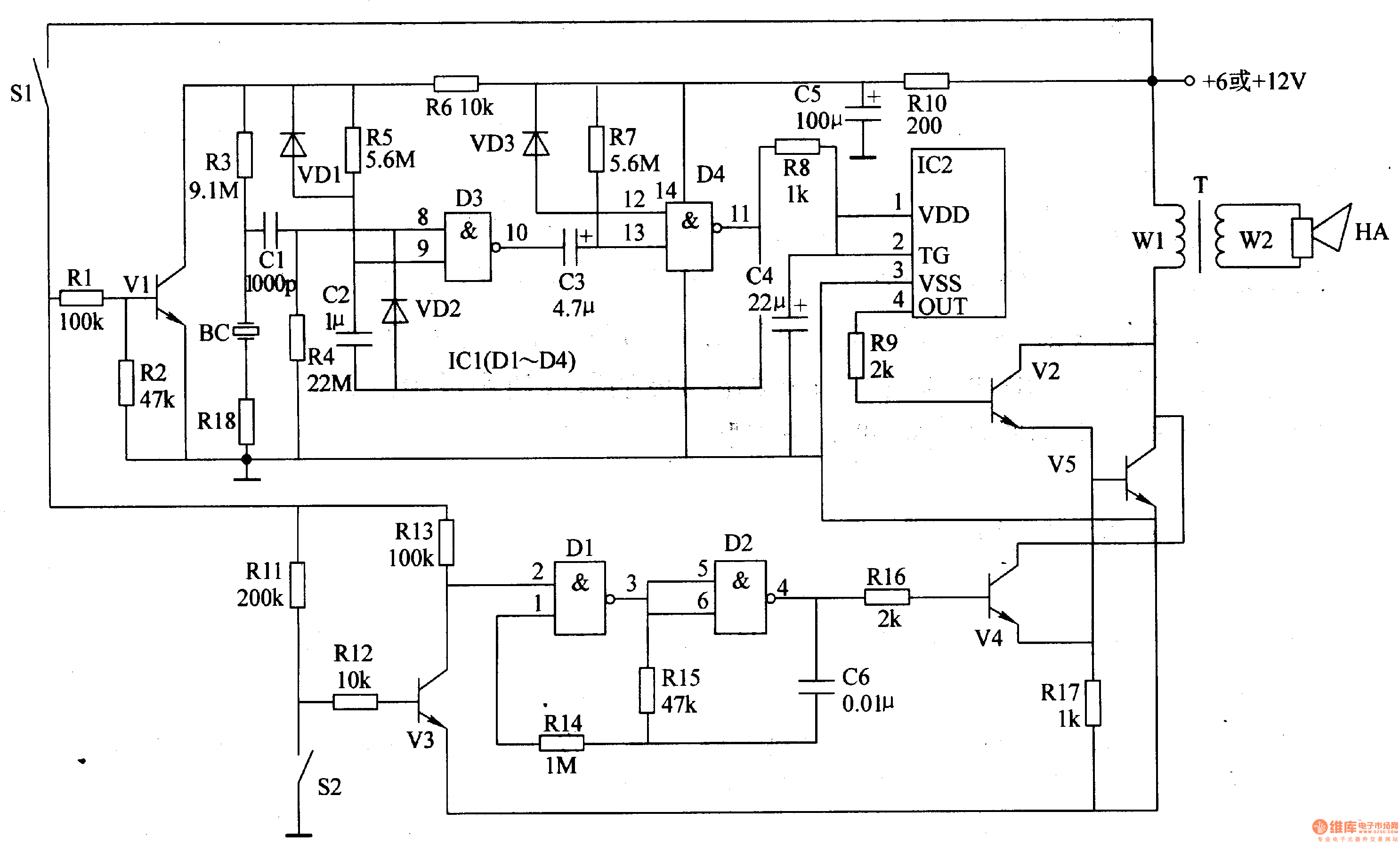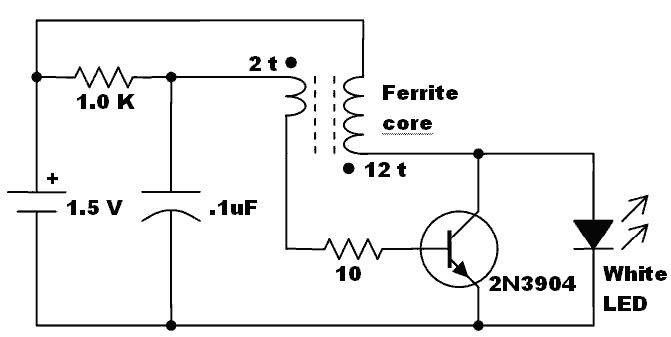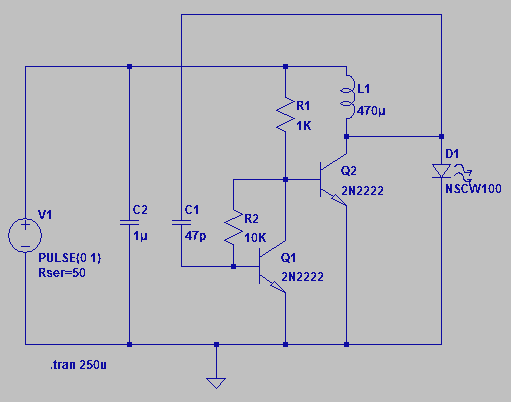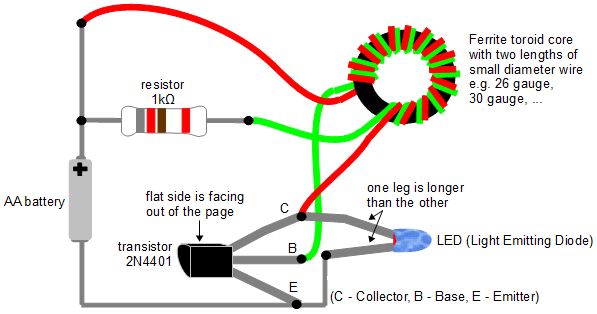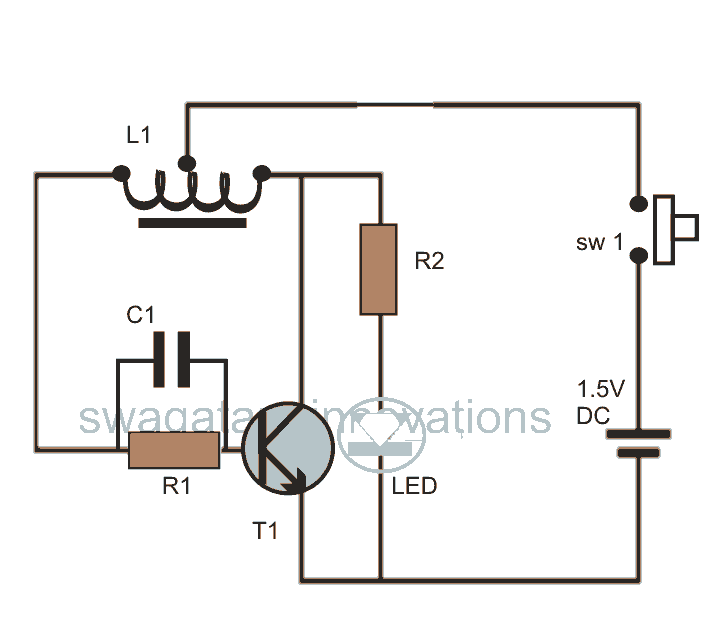
Joule Thief
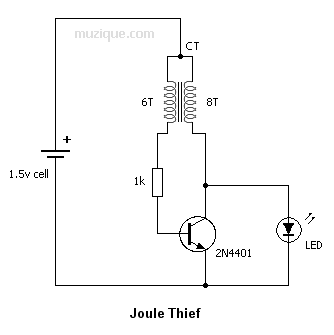
The circuit consists of four main components: an indicator LED, a hand-wound coil, a 1k resistor, and a 2N4401 transistor. The coil is made from solid core telephone wire, with a total of 14 turns wound around the core, creating a center tap. The circuit is powered by a depleted AAA battery, which has a voltage of less than 1V. Since the forward voltage threshold for an LED ranges from 2V to 3.5V, a single 1.5V cell is insufficient to illuminate the LED without additional circuitry. The coil and transistor form an oscillator that generates voltage pulses, allowing the LED to light up brightly, making it usable as a flashlight in confined spaces. This design effectively utilizes discarded batteries that are no longer suitable for other applications. The circuit can be integrated into a pedal operating on 1.5V power to drive the LED indicator. Alternative colored LEDs, such as red, blue, or green, can replace the white LED used in this setup. Enhancements to the circuit can be achieved by using smaller gauge wire and increasing the number of turns on the coil. Plans include rewiring the core with 38 gauge solid wire to achieve 20 or more turns on each coil section, which will improve overall performance.
The circuit operates as a simple oscillator, utilizing the 2N4401 transistor to amplify the voltage generated by the hand-wound coil. The coil, with its center tap, allows for a feedback mechanism that sustains oscillation. When the circuit is powered by the depleted AAA battery, the low voltage is insufficient to directly drive the LED. However, the oscillation produced by the coil and transistor setup creates voltage spikes that exceed the forward voltage threshold of the LED, enabling it to emit light.
The choice of a 1k resistor is critical in this configuration, as it limits the current flowing through the transistor and protects the LED from excessive current that could cause damage. The hand-wound coil's design, with a specific number of turns and the use of solid core wire, directly influences the inductance and the efficiency of the oscillation. The use of a center-tapped coil is particularly advantageous, as it allows for a balanced feedback loop that stabilizes the oscillation frequency.
To enhance the circuit's performance, using smaller gauge wire will reduce the resistance of the coil, allowing for more efficient energy transfer. Increasing the number of turns on the coil will also improve the inductance, resulting in higher voltage spikes and a brighter LED output. The proposed rewiring with 38 gauge wire will enable a more compact coil design while maximizing the number of turns, further optimizing the circuit's functionality.
This circuit exemplifies a practical application of basic electronic components to create a functional light source from otherwise unusable batteries, showcasing innovation in circuit design and component utilization.There are only 4 parts to the circuit, including the indicator LED. There is a hand-wound coil, a 1k resistor, a 2N4401 transistor and the LED. I quickly threw this together by just wiring the component leads together and it worked right away. The coil is wound with solid core telephone wire that was in my junk box. I wound 8 turns of wire (green) , then connected another piece of wire (white) to the first and continued winding for 6 more turns. This makes a center tap when the two wire were joined. I would have wound 8 turns with both pieces of wire but the middle of the core was filled with wire and I could not get the last two turns in place. The battery powering this circuit is a depleted AAA that had less than 1v remaining in it. Since the forward voltage threshold of an LED is from 2v (red) to 3. 5v (white), a single 1. 5v cell will not be able to light up the indicator without some external circuitry. With this circuit, the coil and transistor form an oscillator that sends increased voltage pulses to the LED and this lights it up (quite brightly).
The white light from the LED is bright enough to use as a flashlight in small spaces, and it makes use of discarded batteries that are too weak to use in other applications. The small circuit could be mounted inside a pedal that was using 1. 5v power, to drive the LED indicator. A red, blue or green colored LED could be used in place of the white shown here. The circuit can be improved by using smaller gauge wire and winding more turns on the core. I plan on rewiring the core with some 38 ga. solid wire that I had used for a wah inductor. I should be able to get 20 or more turns on each coil section, and this will improve performance. 🔗 External reference
The circuit operates as a simple oscillator, utilizing the 2N4401 transistor to amplify the voltage generated by the hand-wound coil. The coil, with its center tap, allows for a feedback mechanism that sustains oscillation. When the circuit is powered by the depleted AAA battery, the low voltage is insufficient to directly drive the LED. However, the oscillation produced by the coil and transistor setup creates voltage spikes that exceed the forward voltage threshold of the LED, enabling it to emit light.
The choice of a 1k resistor is critical in this configuration, as it limits the current flowing through the transistor and protects the LED from excessive current that could cause damage. The hand-wound coil's design, with a specific number of turns and the use of solid core wire, directly influences the inductance and the efficiency of the oscillation. The use of a center-tapped coil is particularly advantageous, as it allows for a balanced feedback loop that stabilizes the oscillation frequency.
To enhance the circuit's performance, using smaller gauge wire will reduce the resistance of the coil, allowing for more efficient energy transfer. Increasing the number of turns on the coil will also improve the inductance, resulting in higher voltage spikes and a brighter LED output. The proposed rewiring with 38 gauge wire will enable a more compact coil design while maximizing the number of turns, further optimizing the circuit's functionality.
This circuit exemplifies a practical application of basic electronic components to create a functional light source from otherwise unusable batteries, showcasing innovation in circuit design and component utilization.There are only 4 parts to the circuit, including the indicator LED. There is a hand-wound coil, a 1k resistor, a 2N4401 transistor and the LED. I quickly threw this together by just wiring the component leads together and it worked right away. The coil is wound with solid core telephone wire that was in my junk box. I wound 8 turns of wire (green) , then connected another piece of wire (white) to the first and continued winding for 6 more turns. This makes a center tap when the two wire were joined. I would have wound 8 turns with both pieces of wire but the middle of the core was filled with wire and I could not get the last two turns in place. The battery powering this circuit is a depleted AAA that had less than 1v remaining in it. Since the forward voltage threshold of an LED is from 2v (red) to 3. 5v (white), a single 1. 5v cell will not be able to light up the indicator without some external circuitry. With this circuit, the coil and transistor form an oscillator that sends increased voltage pulses to the LED and this lights it up (quite brightly).
The white light from the LED is bright enough to use as a flashlight in small spaces, and it makes use of discarded batteries that are too weak to use in other applications. The small circuit could be mounted inside a pedal that was using 1. 5v power, to drive the LED indicator. A red, blue or green colored LED could be used in place of the white shown here. The circuit can be improved by using smaller gauge wire and winding more turns on the core. I plan on rewiring the core with some 38 ga. solid wire that I had used for a wah inductor. I should be able to get 20 or more turns on each coil section, and this will improve performance. 🔗 External reference
